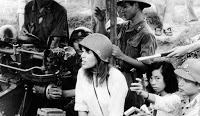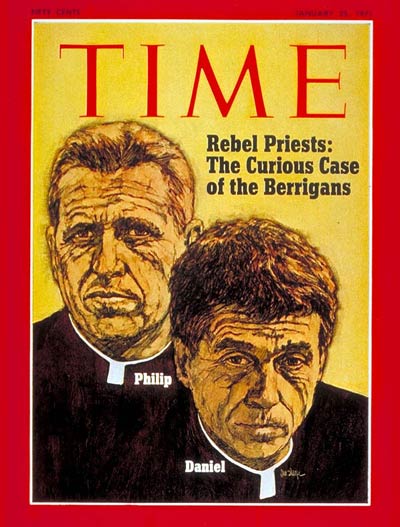Which Way the Trolley: America’s Hot Wars During the Cold War, Part 2
The Left narrative was anti-historical as it gave a distorted view of the world and the war. For one, the Marxist Left rarely acknowledged or credited the reports of the Communist genocides or systematic tyranny, or excused them as irrelevant to the current situation.[8] In other words history was not a warning to the future. They certainly did not consider that a similar genocide could happen in Indochina if Americans were driven out. They considered the “anti-Imperial” forces in Indochina, Viet Ming or Khmer Rouge, as heroes, and their coming socialist economic policies would usher in social justice and prosperity.
 In this regard, the single most disturbing incident for those of us who served in Vietnam was that committed by Jane Fonda, the actress. She toured North Vietnam at the height of the war, and posed as a gunner aiming her weapon towards the sky in solidarity with the North Vietnamese and against her own countrymen. This was perhaps moral treason, but not legal treason, as war had never been declared and thus no charges could be brought against her.
In this regard, the single most disturbing incident for those of us who served in Vietnam was that committed by Jane Fonda, the actress. She toured North Vietnam at the height of the war, and posed as a gunner aiming her weapon towards the sky in solidarity with the North Vietnamese and against her own countrymen. This was perhaps moral treason, but not legal treason, as war had never been declared and thus no charges could be brought against her.
A manifestation of the Left’s anti-historical and ideological perspective was its caricature of President Johnson and the administration leadership that decided on the Vietnam intervention. For them, Johnson was a tool of the military industrialist complex. No consideration was given to his historical experience in seeing the Munich appeasement of Hitler, or the tragic history of fighting a hard war with civilian casualties against Nazism. Most cruelly, the opposition did not credit the administration’s real attempts to limit civilian casualties as in the rigorous rules of engagement. Their chant against Johnson was, “Hey hey, how many kids did you kill today.”
The other major movement of opposition started slowly and was not generally radical or Marxist. It was made up of persons who simply viewed the war as a waste of resources and human lives that did not ultimately matter to Americans. They were appalled by the reports of civilian deaths and injuries that occurred during the course of the fighting and wanted it stopped immediately. Further it became increasingly clear that the South Vietnamese governments were corrupt, and not worth American lives. All of these arguments were reasonable, but they voided the heritage of anti-communism from Truman and Eisenhower, and so eloquently defined by Kennedy.
Circumstances don’t often provide the best of allies.
The third group was a Religious-Civil Rights coalition, which blended with the other groups to varying degrees. Their main focus was that so much work had to be done on civil rights and poverty abatement in the United States that no monies or effort should be spent on the Vietnam conflict. Further, taking their cue from the other groups, they accepted the view that the Vietnam War was immoral because of its civilian casualties, etc., and should be stopped immediately. Significantly, this group did not argue about the Niebuhr position of evil and violence, they simply avoided the issue and centered on the evidence of mounting civilian deaths as the ultimate arbiter of the issue.
Their argument also lacked historical reference or understanding. World War II was fought by a segregated America with a segregated armed forces. We did not stop the war to fix those problems before battling either the Germans or Japanese. Yes, President Roosevelt should have moved to desegregate the Armed Forces, as Truman did when he became president (1948). But the inherited sins of slavery and Jim Crow segregation did not negate the fact that the fight against Japanese and German imperialisms was truly epochal and of preeminent importance.
Berrigan Brothers and the theology of Gnostic pacifism
The theology of the Religious-Civil Rights coalition was formulated and expressed with a masterful eye for publicity by two brothers who were also Catholic priests, Daniel and Michael Berrigan.[11] Michael had served as an infantry office in World War II and was shocked by the racism and discrimination against African American soldiers he saw in Army boot camp. Later, in Europe he experienced combat and was appalled by the destruction and cost of war. Daniel, the younger brother, never entered the armed forces, but was influenced by his brother’s tales.
Daniel Berrigan met and befriended Dorothy Day, the editor of the Catholic Worker, a very Left and a pacifist journal. Daniel recalled:
“Dorothy Day taught me more than all the theologians,” Berrigan told The Nation in 2008. “She awakened me to connections I had not thought of or been instructed in—the equation of human misery and poverty with warmaking. She had a basic hope that God created the world with enough for everyone, but there was not enough for everyone and warmaking.”[12]
This is the type of naïveté that would have made Niebuhr recoil. War certainly destroys property and lives. But as we have learned after decades of ineffective foreign aid, there is a much closer connection to endemic poverty between lack of the rule of law, corruption of governments, and counter economic populist policies such as price controls than to war. This is exemplified by the impoverishment of the people of Myanmar through their long lasting socialist government, and most recently by the debacle of the Marxist/Populist regime in Venezuela.
 In any case the Berrigan brothers swallowed the Dorothy Day simplification whole, and became full time protestors to the Vietnam War. Like Jane Fonda, Daniel Berrigan went to Hanoi to express solidarity with North Vietnamese as he obtained the release of several American POWs. Their most famous protest occurred in May of 1968 when the two brothers and seven other activists entered a Selective Service office and took draft notification, poured home-made napalm on them and set them on fire. They were tried and found guilty of destruction of government property and served jail time, but garnered immense publicity for their cause. They even made the cover of Time Magazine (January 25, 1971).
In any case the Berrigan brothers swallowed the Dorothy Day simplification whole, and became full time protestors to the Vietnam War. Like Jane Fonda, Daniel Berrigan went to Hanoi to express solidarity with North Vietnamese as he obtained the release of several American POWs. Their most famous protest occurred in May of 1968 when the two brothers and seven other activists entered a Selective Service office and took draft notification, poured home-made napalm on them and set them on fire. They were tried and found guilty of destruction of government property and served jail time, but garnered immense publicity for their cause. They even made the cover of Time Magazine (January 25, 1971).
I term the Berrigan Brothers “Gnostic pacifists.” Gnostics, both biblical and modern, base their beliefs on visions, feelings, and emotions, and give little weight to tradition, established scriptures, or the past.[13] The Berrigan anti-war theology was similarly fueled by the images (photographic vision) of children killed or maimed in the Vietnam war, and of illusion that socialism and the end of the American involvement in the war would bring peace, prosperity and happiness to South East Asia. Their theology expressed nothing of the Christian Just War understanding, little historical knowledge, and nothing of the tragic sense of history in Niebuhr’ theology.
Category: Church History, Winter 2017


